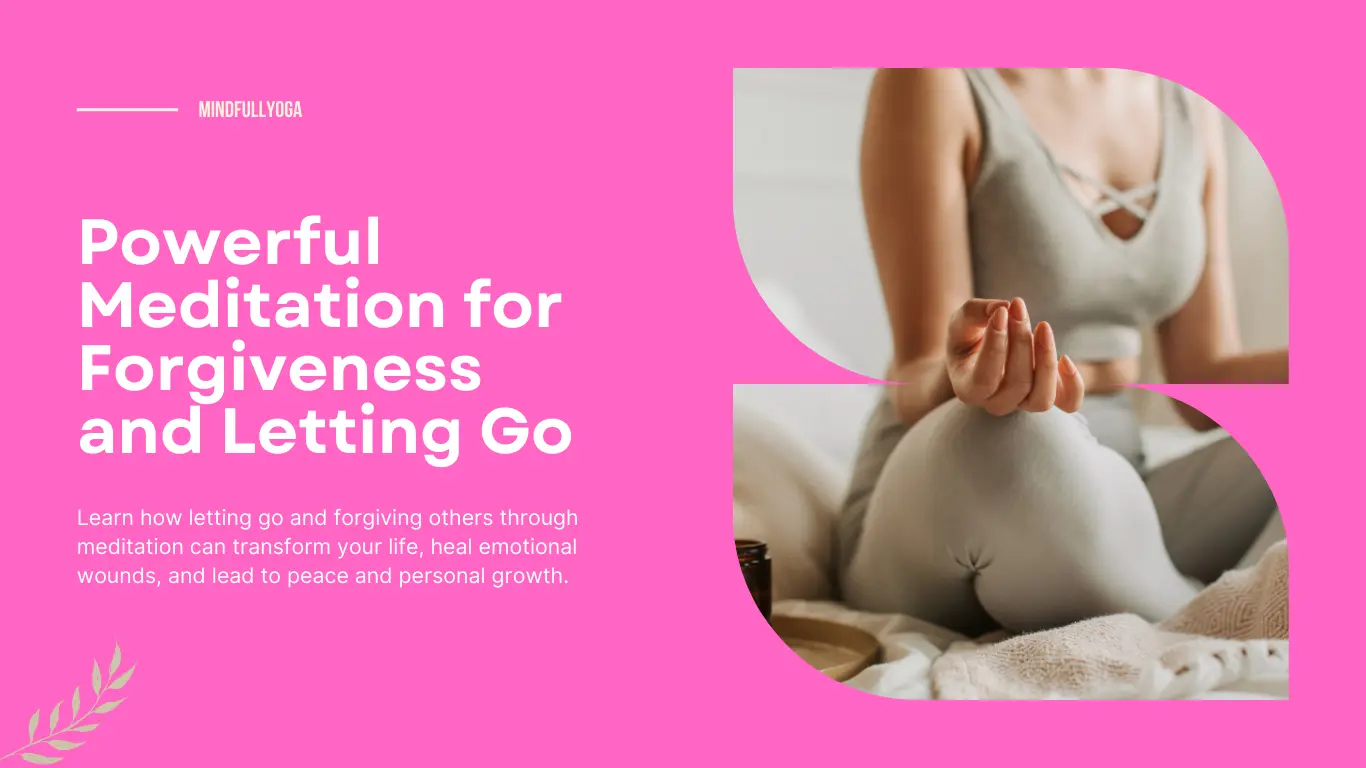
Have you ever felt stuck by unresolved hurt or resentment? I know the feeling well. Meditation for forgiveness and letting go has changed my life. It heals emotional scars, lowers stress, and boosts personal growth.
Forgiveness is hard, but it’s key to feeling whole again. Letting go of past hurts frees you from resentment. It opens the door to self-acceptance, compassion, and better emotional health. Meditation helps you release negative feelings, leading to a happier, more meaningful life.
Key Takeaways:
- Meditation can help heal emotional wounds and promote forgiveness
- Letting go of resentment and past hurts leads to greater inner peace
- Forgiveness is a crucial step in achieving personal growth and fulfillment
- Meditation techniques can systematically release negative emotions
- Developing a regular forgiveness practice can improve overall well-being
Table of Contents
Understanding the Power of Forgiveness Through Meditation
Forgiveness meditation is a powerful tool that changes your mental state and helps you release emotions. It teaches you to let go of resentment and find inner peace. This journey starts with understanding the benefits of forgiveness.
The Psychological Benefits of Letting Go
When you hold onto negative emotions, you get stuck in a cycle of anger. Forgiveness meditation helps you break free from these feelings. It lets you move forward with clarity and strength. When you forgive you feel better overall, less stressed and your relationships become stronger.
How Forgiveness Transforms Your Mental State
Forgiveness meditation changes how you think. It teaches you to be compassionate, not just to others but to yourself too. This change helps you understand and empathize more, leading to better mental health and emotional balance.
Breaking the Chains of Resentment
Resentment can weigh you down and stop you from moving forward. Forgiveness meditation offers a way to release these feelings. By forgiving, you open yourself to new possibilities and a more positive life.

The Science Behind Meditation for Forgiveness and Letting Go
Exploring the power of forgiveness through meditation is fascinating. It’s important to understand the science behind this practice. The neuroscience of forgiveness shows how your brains change when you let go and become more compassionate.
Studies have found that regular meditation boosts brain plasticity. This leads to changes in brain structure and function. Forgiveness meditation activates parts of the brain linked to empathy, emotional control, and stress reduction.

Forgiveness can also reduce stress. Holding onto resentment increases stress, harming your health. But, through meditation, you can change your brain’s pathways. This promotes inner peace and reduces stress.
Research also shows that forgiveness meditation improves emotional intelligence and relationships. It increases your overall well-being. By using your minds, you can unlock forgiveness’s transformative power and enjoy its benefits.
Creating Your Sacred Space for Forgiveness Practice
Having a special place for meditation is key to forgiveness. This place should be quiet and distraction-free. It helps you focus on your mental and emotional health. A well-thought-out meditation space is ideal for deep reflection and forgiveness.
Essential Elements for Your Meditation Environment
To make your meditation space serene, consider these elements:
- Comfortable seating, such as a cushion or chair, to support your body during practice
- Soft, soothing lighting, like candles or dimmers, to promote a calming ambiance
- Calming scents, such as essential oils or incense, to enhance the meditative experience
- Carefully curated decor, with elements like plants, crystals, or artwork, to inspire mindfulness
- Minimal clutter and distractions to help you stay focused and present
Setting the Right Atmosphere
A successful forgiveness practice starts with a peaceful meditation space. By creating a mindful environment, you make a space for healing. Try several components to determine what works best for you.

Preparing Your Mind and Body for Forgiveness Work
Starting the journey of forgiveness needs mental and physical prep. By focusing on yourself and making a supportive space, you’re ready for a deep meditation. Let’s look at the key steps to get your mind and body ready for this inner work.
Cultivating Mental Readiness
First, prepare your mind. Start with deep breaths to relax your body and calm your mind. Think about why you want to forgive. Choose to forgive generously by imagining the person or situation you want to forgive.
Engaging in a Body Scan
Then, scan your body for any tight spots. Let go of these tensions, making your muscles relax. This helps you get into a mindful state, ready for what’s next.
Setting the Stage for Meditation
Lastly, make a special place for your meditation. Make sure it’s quiet and peaceful. You might light a candle, use incense, or play calming music. These steps help you feel safe and focused, ready to forgive.
With these steps, you’re ready for a deep and healing forgiveness meditation. Remember, forgiveness is personal. By respecting your own needs, you can use this practice to heal and free your mind and heart.
Essential Breathing Techniques for Deep Release
Forgiveness through meditation starts with breathing exercises. These can change you, helping you let go of emotional burdens. Let’s look at two key breathing practices for this journey.
Rhythmic Breathing for Emotional Release
Rhythmic breathing is great for emotional release. This reduces mental stress and provides relaxation. Start by inhaling slowly through your nose, feeling your belly fill with air.
Relieve tension by exhaling slowly through your mouth. Repeat, focusing on your breathing’s rhythm and how it feels.
The Four-Part Breath Method
The four-part breath is another powerful technique. It divides your breath into four parts, making it more mindful. Inhale for four counts, hold for four, exhale for four, and pause for four before starting again.
This method helps release emotional blockages. It brings calm and clarity.
Adding these breathing exercises to your meditation can deeply transform you. By tuning into your breath, you can understand yourself better. This makes letting go of the past easier.
Guided Visualization Practices for Letting Go
Guided visualization meditation is a strong tool for healing past hurts and finding forgiveness. It lets you use your minds and emotions to find release and peace. Let’s look at some visualization exercises that can help you let go and move on.
The Releasing Balloon Visualization
Sit comfortably and close your eyes. Imagine a beautiful, colorful balloon in front of you. See this balloon as all the resentment, anger, or pain you’ve held onto.
Slowly fill the balloon with your difficult emotions, watching it grow. When it’s full, take a deep breath and let the balloon go. Watch it drift up and away, taking your burdens with it.
Feel the lightness and relief as you release what no longer serves you.
Healing Light Meditation
Picture a warm, radiant light coming from your heart center. Let this healing energy spread, filling you with a comforting glow. See this light reaching out to those who have hurt you, embracing them in its warmth.
As you breathe deeply, imagine the light dissolving any emotional pain or resentment. Replace it with understanding and compassion.
These guided imagery practices are great tools on your journey to forgiveness and letting go. By using your imagination, you can unlock deeper healing and self-discovery. Add these visualizations to your meditation routine and see the positive changes in your mind, body, and spirit.
Self-Compassion Exercises in Forgiveness Meditation
Forgiveness isn’t just about letting go of anger towards others. It’s also about being kind to yourself. Through meditation, you can heal old wounds and learn to love yourself more. This helps you be kinder to others too.
Embracing Self-Love Through Meditation
Loving-kindness meditation, or metta meditation, is a great way to practice self-compassion. It involves sending love and acceptance to yourself and others. By doing this, you can stop being too hard on yourself.
Healing Past Wounds with Kindness
Self-forgiveness meditation is another helpful exercise. It helps you forgive yourself for past mistakes. By being gentle with yourself, you can let go of shame and grow.
Forgiveness and self-compassion go hand in hand. By being kind to yourself, you break free from anger and judgment. This opens the door to true healing and wholeness.
Moving Beyond Past Hurts with Mindfulness
Mindfulness is a strong tool for healing past traumas. It helps you stay in the present, embracing your feelings with kindness. This way, you avoid getting stuck in old negative patterns.
Mindfulness teaches you to accept your experiences without judgment. You learn to watch your tough feelings with curiosity, not fear. This change can free you, helping you heal from past wounds.
It also focuses on being in the now. This helps you stop dwelling on the past or worrying about the future. It’s especially useful for those who have faced traumatic events, helping them stay grounded in the present.
Adding mindfulness to your daily routine can help you overcome trauma. It builds resilience and helps you find purpose again. Through meditation, deep breathing, or just noticing your surroundings, mindfulness can bring peace back into your life.
Incorporating Daily Forgiveness Rituals
Adding forgiveness meditation to your daily routine can help you heal emotionally and grow personally. It’s a way to let go and be kind to yourself. This practice can change your life for the better.
Morning Practice Routines
Begin your day with a forgiveness ritual. It could be a short meditation, writing down things you’re grateful for, or repeating positive affirmations. Just 10-15 minutes a day can make a big difference. It helps you start the day feeling clear and peaceful.
Evening Release Ceremonies
End your day with a forgiveness ritual to clear out any negative feelings. You might do a guided meditation, a body release exercise, or reflect on your day. This helps you relax and sleep better.
Consistency is key to getting the most out of forgiveness meditation. Try to do these rituals every day, even if it’s just for a few minutes. With time, they will become a powerful way to heal and grow.
Deepening Your Practice with Advanced Techniques
As you move forward in your journey of forgiveness and self-discovery, it’s key to try advanced meditation techniques. These go beyond basic breathing and guided visualizations. Tools like forgiveness journaling, shadow work, and emotional integration can reveal deep insights and speed up your healing.
Forgiveness journaling is a powerful tool that helps you process your feelings. It improves your understanding of both yourself and other people. You can gain clarity and get rid of hostility by putting your thoughts on paper.
Shadow work is another game-changer in advanced meditation. It’s about facing the parts of yourself you might hide or deny. You can confront these hidden elements and integrate them, which will help you accept who you are.
Emotional integration is also a key technique. It’s about feeling and processing your emotions fully. This way, you can release them, develop self-compassion, and start a true healing journey.
Remember to be patient and kind to yourself as you explore these advanced practices. Forgiveness and self-discovery are lifelong paths. Every step you take shows your courage and dedication to growing.
- Explore the power of forgiveness journaling
- Embrace shadow work to uncover hidden aspects of yourself
- Practice emotional integration to process and release deep-rooted feelings
Closing
Meditation for forgiveness and letting go is incredibly powerful. It helps you change your inner world. This change lets you move past the past and look forward to a brighter future.
The meditation benefits we’ve seen are amazing. They show how meditation can improve your mental health and help you be kinder to yourself. By meditating on forgiveness, you can let go of anger and start healing.
I urge you to keep exploring meditation. Include this in your daily routine. As you do, you’ll see a new, happier, and stronger you emerge. This new you will be filled with inner peace and self-love.
Also Read: Fun Winter-Themed Yoga for Kids: Let’s Become Snowflakes and Polar Bears!
Also Read: How to Create a Nutritious Christmas Dinner Menu That Everyone Will Love
Also Read: Chakra Yoga for Beginners: Unlock 7 Chakras in Human Body and Their Significance




